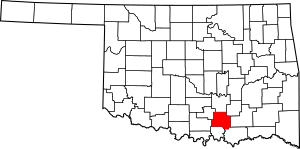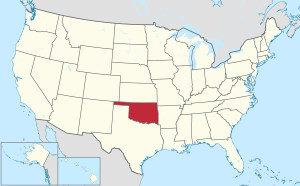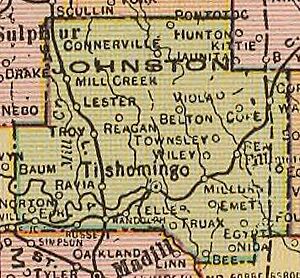Johnston County, Oklahoma facts for kids
Quick facts for kids
Johnston County
|
|
|---|---|

|
|

Location within the U.S. state of Oklahoma
|
|
 Oklahoma's location within the U.S. |
|
| Country | |
| State | |
| Founded | 1907 |
| Named for | Douglas H. Johnston |
| Seat | Tishomingo |
| Largest city | Tishomingo |
| Area | |
| • Total | 658 sq mi (1,700 km2) |
| • Land | 643 sq mi (1,670 km2) |
| • Water | 15 sq mi (40 km2) 2.3%% |
| Population
(2020)
|
|
| • Total | 10,272 |
| • Density | 15.611/sq mi (6.027/km2) |
| Time zone | UTC−6 (Central) |
| • Summer (DST) | UTC−5 (CDT) |
| Congressional district | 2nd |
Johnston County is a county in the state of Oklahoma. In 2020, about 10,272 people lived there. The main town and county seat is Tishomingo.
Johnston County became a county on November 16, 1907, when Oklahoma became a state. It was named after Douglas H. Johnston, who was a leader of the Chickasaw Nation. This county is also part of the Texoma Region, which is an area around the border of Texas and Oklahoma.
Contents
History of Johnston County
In 1820, the U.S. government gave the land that is now Johnston County to the Choctaw tribe. Many Choctaw people started moving to this new land, called Indian Territory, in 1830.
The Chickasaw tribe, who were related to the Choctaw, later separated from the Choctaw Nation. They moved to the western part of the Choctaw Nation in the late 1830s. The Chickasaw Nation chose Tishomingo as their capital. They built a brick capitol building there in 1856.
Before the American Civil War, several schools were started in the Chickasaw Nation. The Pleasant Grove Mission School and the Chickasaw Academy opened in 1844. The Wapanucka Female Manual Labour School opened in 1852.
During the Civil War, the Chickasaw government joined the Confederate States of America. The Union army left their forts in the area, like Fort Washita and Fort Arbuckle. Confederate soldiers then used the stone building at Wapanucka as a hospital and a prison.
Around the early 1900s, several railroads built tracks through Johnston County. These railroads helped connect the area to other parts of the country. Today, the Burlington Northern and Santa Fe is the only railroad still operating in the county.
Geography and Nature
Johnston County covers about 658 square miles. Most of this area, about 643 square miles, is land. The rest, about 15 square miles, is water.
The northern part of the county has the Arbuckle Mountains. These mountains have rocky areas and rolling hills. The southern part of the county is flatter and better for farming.
The county has several rivers, including the Washita and Blue Rivers. These rivers flow into the Red River. A part of Lake Texoma also reaches into southern Johnston County.
Main Roads in Johnston County
 U.S. Highway 377
U.S. Highway 377 State Highway 1
State Highway 1 State Highway 7
State Highway 7- State Highway 12
 State Highway 22
State Highway 22 State Highway 48
State Highway 48 State Highway 78
State Highway 78
Neighboring Counties
- Pontotoc County (north)
- Coal County (northeast)
- Atoka County (east)
- Bryan County (southeast)
- Marshall County (south)
- Carter County (west)
- Murray County (northwest)
Protected Natural Areas
- Tishomingo National Wildlife Refuge (part)
Population and People
| Historical population | |||
|---|---|---|---|
| Census | Pop. | %± | |
| 1910 | 16,734 | — | |
| 1920 | 20,125 | 20.3% | |
| 1930 | 13,082 | −35.0% | |
| 1940 | 15,960 | 22.0% | |
| 1950 | 10,608 | −33.5% | |
| 1960 | 8,517 | −19.7% | |
| 1970 | 7,870 | −7.6% | |
| 1980 | 10,356 | 31.6% | |
| 1990 | 10,032 | −3.1% | |
| 2000 | 10,513 | 4.8% | |
| 2010 | 10,957 | 4.2% | |
| 2020 | 10,272 | −6.3% | |
| U.S. Decennial Census 1790-1960 1900-1990 1990-2000 2010 |
|||
In 2000, there were 10,513 people living in Johnston County. There were about 4,057 households, which are groups of people living together. The average household had about 2.5 people.
Most people in the county were White (76.09%). About 15.32% were Native American. Most people spoke English (97.0%).
The median age in the county was 38 years old. This means half the people were younger than 38 and half were older. About 25.5% of the population was under 18 years old.
The median income for a household was about $24,592 per year. This is the middle income for all households.
Education in Johnston County
Murray State College is an important school in Johnston County. It first opened in Tishomingo in 1908 as the Murray State School of Agriculture. Its name changed to Murray State College in 1972.
Towns and Communities
Cities
- Tishomingo (the county seat)
Towns
Census-Designated Places
These are areas that are like towns but are not officially incorporated.
Other Small Communities
Famous People from Johnston County
- Bill Anoatubby: A governor of the Chickasaw Nation.
- Neill Armstrong: A coach for the Chicago Bears football team.
- Gene Autry: A famous American singer and actor who grew up in Ravia.
- Te Ata Fisher: A Chickasaw storyteller, born in Emet.
- William H. "Alfalfa Bill" Murray: A former governor of Oklahoma.
- Johnston Murray: Son of William H. Murray, and also a governor of Oklahoma.
- Harriet Wright O'Leary: A teacher and politician, and the first woman on the tribal council of the Choctaw Nation of Oklahoma.
See also
 In Spanish: Condado de Johnston (Oklahoma) para niños
In Spanish: Condado de Johnston (Oklahoma) para niños


